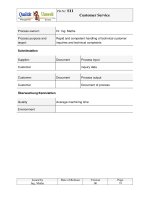TEN SECRETS FOR SUCCESSFUL CUSTOMER SERVICE ppt
Bạn đang xem bản rút gọn của tài liệu. Xem và tải ngay bản đầy đủ của tài liệu tại đây (439 KB, 16 trang )
TEN SECRETS FOR SUCCESSFUL
CUSTOMER SERVICE
The Insider’s Guide to Customer Service on the Web
Ten Secrets for Successful Customer Service
by Greg Gianforte, RightNow
Technologies
The Insider’s Guide to Customer Service on the Web
Ten Secrets for Successful Customer Service
by Greg Gianforte, RightNow
Technologies
© 2005 Ri
g
htNow Technolo
g
ies, Inc.
Contents
Executive Summary
1
2
3
5
7
8
10
12
13
13
Why Web-Based Customer Service?
Web-Based Service Innovators: Cases-In-Point
Ten Secrets for Successful Web-Based Customer Service
Bottom Line Benefits of Web-Based Customer Service
What’s Your Company’s SQ?
RightNow
Service™: Customer Service Made Easy
Industry Response
About the Author
About RightNow Technologies
© 2005 RightNow Technologies, Inc.
Executive Summary
The web is a great place to do customer service. It's where people go to find
answers fast. It provides a way for customers to navigate their way through
lots of content to find the particular piece of information they need. It's open
seven days a weeks, 24 hours a day. In fact, according to industry
observers, web-based customer service is one of the biggest business
opportunities on the web.
Unfortunately, most companies fail to effectively exploit the web's
full potential as a customer service vehicle. Some fail because they
don't recognize just how powerful of a business tool web-based customer
service can be. Some fail because they never develop a practical process for
capturing the information their customers want and quickly getting it onto
their site—or they fail to keep such information properly updated. Others fail
to adequately integrate web self-service with their email and call center
channels. Others leave out some of the key functions that make web
customer service really "click"—such as store locators or remote web session
control.
There is a cost for such failure. Companies that don't develop effective
Internet customer service wind up spending far more on customer
support than their competitors—as much as 20 times more per
incident. That’s because, without effective customer service, companies
must rely on their over-burdened, high-cost call centers to answer even the
most routine and repetitive customer inquiries. Companies with poor service
also lose customers, since web users get frustrated quickly and head
elsewhere.
Web-based customer service is a great way to habituate customers to using
your web site, thereby creating other opportunities to lower transaction
costs, execute cross- and up-selling strategies, and otherwise leverage the
Internet as a business tool. And, because it’s so scalable, web-based
customer service offers an extremely cost-effective solution for dealing with
the inevitable peaks and valleys in your service incident volume. That’s why
web-based service has become such a hot topic for business and technology
managers alike.
1
© 2005 RightNow Technologies, Inc.
This white paper distills the experience and best practices of successful web-
based service implementers from a wide range of industries. It also provides
a simple test for determining your company's Service Quotient, or "SQ."
With this insider information, you'll be able to plan and implement your own
customer service strategy—and join the ranks of successful Internet service
pioneers who have significantly lowered their per-incident customer support
costs while consistently delighting their customers and strengthening their
Internet presence.
Why Web-Based Customer Service?
As it becomes increasingly popular and well traveled, the web is rapidly
changing. Just a few short years ago, it was enough for a business to put up
a site that had a modest amount of information on its products or services,
with a phone number to contact if the visitor wanted to order something or
ask questions. This static "brochureware" content treated the web as an
online Yellow Pages, where the main idea was to make sure you were
properly listed.
Things have really changed. Now, the web is an intensively interactive
medium and an online extension of the business itself. Companies use the
web to buy, sell, recruit staff, solicit bids and make referrals. It's also a
great place to support customers and forge closer relationships with them.
That means it's also a great place to lose customers, too.
How do you lose customers on the web? The same way you lose them in the
"real" world: you don't respond to their needs. Unfortunately, many
executives who would have a heart attack if their sales and service
staffs were unresponsive or ignorant about the company’s products
don’t show the same concern about having an unresponsive or
ignorant web site. Their web sites can’t answer customers’ questions.
They take too long to reply to customer emails—or they fail to reply at all.
Keep in mind that a fundamental aspect of the web's appeal is the immediate
gratification it offers. When someone comes to your web site, they want to
quickly find the information they need to make a buying decision or solve a
problem. So web visitors are very sensitive to delays. It may be only a
matter of seconds before a visitor gives up his or her search, and tries
looking elsewhere.
This puts tremendous pressure on the two groups who develop web content:
marketing and customer service. They must somehow anticipate the
possible needs of all types of visitors, from clueless newcomers to long-time
customers. This is clearly a tough job, and in today’s resource-constrained
business environment, it’s not a job that anyone wants to spend a lot of time
doing.
Fortunately, you don’t have to. Internet customer service innovators
have proven that you can answer a tremendous percentage of
customers’ questions online without spending money and time you
don’t have.
2
© 2005 RightNow Technologies, Inc.
But before we look at how they accomplished this, let’s look at who they are
and what they’ve been able to do.
Web-Based Service Innovators: Cases-In-Point
As more companies deploy web-based customer service, their successes
demonstrate the bottom line business benefits gained by effectively
supporting customers online. Here is just a sampling of companies that use
automated, web-based customer support to lower operational costs and
significantly improve customer satisfaction.
Allied Telesyn: Self-Service for High-Tech Questions
When global communications equipment provider Allied Telesyn entered the
home PC networking market, it found itself having to support a large number
of novice users. Call center operators had to answer repetitive questions as
simple as, "What's an IP address?" Because of the technical sophistication of
Allied’s operators, support calls cost the company around $50. Allied needed
to reduce these calls while still supporting its new products.
Its web-based solution worked. Allied experienced a 15% drop in the first
month of its implementation and 20% the second month. Use of the
company’s online support page climbed by almost 25%, with customers
commenting regularly on how much they like being able to go to the site
anytime to find what they want. The company has saved $25,000 per
month through the reduction of phone calls alone.
New York DMV: The Web Does the Work
NY Department of Motor Vehicles supports New York State’s 10 million
drivers with a complete range of services including licensing and vehicle
registration. The agency’s web site is its busiest “office,” receiving almost
16,000 hits per day. Its original goals for self-service were quite modest. If
better use of the web could reduce email traffic by 30%, then the agency’s
investment in self-service would have paid for itself.
But in the first week of deployment, email volume dropped 33%. After a few
small changes to the verbiage on the site, the agency achieved another 18%
reduction. Further refinements eventually resulted in a total email reduction
of 88%.
Just as remarkable as this huge reduction in email volume is the percentage
of site visitors who find answers to their own questions without having to
send an email or make a phone call to DMV personnel. A full 99.2% of all
site visitors who look for answers are now able to find them without
any assistance. The result: Huge operational cost savings for the agency
and significantly improved service to the state’s drivers—who can now get
immediate answers to their questions 24 hours a day.
3
© 2005 RightNow Technologies, Inc.
Wolters Kluwer Health: Saving the Call Center
International medical publisher Wolters Kluwer Health was moving its
business online to cut costs and streamline distribution. Online customers,
however, ask lots of questions via email. Wolters Kluwer Health couldn’t
respond to those emails quickly enough, so customers began picking up the
phone. The call center got swamped and customer service began to suffer.
Fortunately, they quickly implemented web self-service to address the
problem. Visitors to the Wolters Kluwer Health site were able to successfully
find answers to their own questions. Within weeks, they experienced a
22% reduction in call volume. That brought phone response times down
under a minute—which, in turn, meant that 7,000 fewer calls were being
abandoned before they could be answered. That’s a huge improvement in
the quality of the company’s customer service.
4
© 2005 RightNow Technologies, Inc.
Ten Secrets for Successful Web-Based Customer Service
As these companies and others prove, effective customer service is actually a
very achievable goal—even for companies with relatively limited resources.
It simply requires the right principles, practices and tools. By surveying
today's most effective customer service practitioners, RightNow Technologies
discovered ten basic attributes that make web-based customer support work:
1. Make sure your web site "listens" to customers
Every successful salesperson knows the most important part of their job
is listening—both for explicit and implicit messages from the customer.
Web sites should do the same. Explicit messages are clear requests for
specific information. Implicit messages are patterns of queries or usage
that imply a difficulty in finding some type of content. Effective customer
service requires mechanisms and/or practices that ensure an attentive
ear to both types of messages from customers.
2. Give customers what they want—quickly
Once you’ve “heard” what kind of information customers want, you have
to give it to them—quickly. The web is all about immediacy. So whether
it’s getting new information posted onto your site or responding to
incoming emails, your service solution must enhance your ability to
respond quickly. Don’t confuse this with the rapid posting of information
marketers want to put on your site. Quality customer service
requires the rapid posting of customer-driven content.
3. Make customer service resources easy-to-find and easy-to-use
Great content isn’t much use if customers can’t find it easily. That’s why
content has to be well-organized into hierarchical “containers” that
reflect the way users actually think about and search for content—not
how a web site manager guesses they might. It’s also important to
always give customers the ability to turn to email, live chat or a live
operator.
4. Integrate all your communications channels
Different customers will use different communications channels at
different times. So it’s important to be able to leverage your
knowledge base across all channels and to be able to track
incidents across all channels as well. That way, when customers call
you after exchanging emails with you, they won’t have to repeat
everything they explained in their emails—and vice versa. The result:
happier customers and faster problem resolution.
5
© 2005 RightNow Technologies, Inc.
5. The "80/20" rule
Successful customer service doesn’t require the ability to answer every
conceivable customer question online. More than 80% of all customer
questions are usually answered by just 20% of a support knowledge
base. In fact, studies show that web-based customer service
implementers have been able to answer 86% of all customer
queries online with a relatively small, focused set of knowledge
items. It’s more important to get started with a web-based customer
service solution than it is to develop the “perfect” service/support
knowledge base. Smart companies get the most important information
up first, and then add to it over time.
6. Let your customers rate you
You can’t improve what you don’t measure. That’s why it’s important to
let users rate the effectiveness of the knowledge items they find on your
web site as well as any email replies received in response to their
requests for help. Using this feedback, you quickly weed out content
that’s not helpful—thereby improving your site’s effectiveness as a
service/support resource for customers.
7. Leverage your knowledge base
It’s worth creating a knowledge base just for web-based service; but you
can achieve even greater return on investment (ROI) by leveraging that
knowledge base across all your customer interaction channels (i.e. web,
email, chat and phone). For example, the same knowledge base
customers use to get their questions answered online can also be used
by new call center operators as an information resource—helping them
become more productive more quickly.
8. Connect the online world to the real world
One of the most important strategic imperatives for retailers, companies
that sell through distributors and many others, is to link online
operations with real-world facilities. After all, many customers come
to a web site as a prelude to visiting a store or service center.
And one of the best ways to do this is to include a searchable database of
real-world locations in your online service resources. It’s also important
to supplement street addresses with maps and driving directions to
ensure that your customers can get where they want to go without
getting lost!
9. Consider hosted applications
At a time when companies have a limited ability to buy, implement and
manage new technologies, many successful web-based service
implementers are turning to a hosted model. This approach
eliminates the capital cost of software and hardware as well as
the staffing requirements associated with implementing and
maintaining a web-based customer service solution. Hosted
systems let companies rapidly reap the benefits of web-based service
without disrupting their existing IT operations.
6
© 2005 RightNow Technologies, Inc.
10. Buy experience along with your technology
Online customer service technologies can be very powerful. But you
have to know what you’re doing to get the most out of them. That’s why
the smart web-based service implementers look for a source of
substantial customer service experience to complement the technologies
they acquire. Best practices like those listed here are extraordinarily
valuable. So it makes sense to partner with someone who can apply
those best practices to your company’s online/offline customer service
initiatives.
These ten simple principles can make the difference between successful,
high-ROI customer service and a failure to take full advantage of the Internet
as a medium for superior customer service. In a market climate where every
competitive advantage counts, few companies can afford to miss out on the
outstanding bottom line benefits that effective web-based customer service
offers.
Bottom Line Benefits of Web-Based Customer Service
Companies that implement effective web-based customer service solutions
find they benefit in numerous ways—many of them totally unexpected. The
bottom line rewards they’ve experienced include:
Reduced cost of customer service
When customers help themselves at a web site instead of having to call a
conventional help desk, savings can range from $10-$45 per incident.
By continuously adding customer-driven content to the site, the percentage
of customers who can help themselves online also increases, dramatically
reducing overall customer support costs.
Faster customer service and increased satisfaction
People hate to sit on "hold." When they can help themselves on a web
site, they can get faster answers to their most pressing questions 24
hours a day, seven days a week. They also develop the perception that
the company site they're visiting has a good handle on its customers’
needs—thereby strengthening their overall confidence in that company.
Increased use of lower cost online transaction channels
For most companies, sales over the web provide lower transaction costs than
those made over the phone or in a retail location. Good customer service
encourages customers to use the web site more often, which means they
become more likely to use it for transaction and support. Web-based service
thus lowers your company’s cost of sales.
The ability to scale to meet peak seasonal volumes
7
© 2005 RightNow Technologies, Inc.
A big problem many companies with seasonal patterns of buying often face is
ramping up to support peak seasonal volumes. Usually, this means adding
call center operators temporarily. But how many do you add? If you add too
many, you’ll waste money on excess capacity. If you add too few, you
won’t be able to respond in a timely manner to your customers. An
effective customer service solution—especially a hosted one—can
easily scale as needed to meet any volume of traffic, without
requiring guesswork or potential over-spending on additional
infrastructure.
Freeing up staff
One of the main constraints on most companies' online efforts is the limited
number of staff members who understand the business and the Internet. By
automating the generation and management of online support resources,
web-based customers service relieves these precious employees of having to
perform many repetitive—yet critical tasks time-sensitive tasks—thereby
freeing them to support other strategic projects.
The bottom line? Responsive, automated, service delivers concrete business
advantages, day in and day out. Online customer service is also rapidly
becoming a competitive necessity, as more and more companies make their
web sites a primary channel for low-cost, customer-pleasing service and
support.
What's Your Company's SQ?
Because web-based service effectiveness has become an important factor in
every company’s overall business strategy, now is a good time to assess the
quality of your own company’s Service Quotient, or SQ. This simple test will
help you determine just how healthy your company's service strategy really
is, and allow you to pinpoint where it could use improvement.
8
© 2005 RightNow Technologies, Inc.
SQ Evaluation Questions
Yes No
Don't
Know
1. Can your customers quickly find answers to
their most frequently asked questions on your
web site?
2. Can they easily check on the status of the
response they previously requested?
3. Do you respond to all customer emails within
one business day?
4. Does the content on your site change
automatically based on customer input?
5. Are the most useful and/or commonly
requested knowledge items presented first?
6. Do customers have an easy way to get to a
human support staffer?
7. Do your customers consistently return to your
site to get information? Do you have any way
of determining whether or not they do?
8. Are you tracking the activity that has taken
place on your site on a week-by-week basis?
Do those reports help you determine the ROI
of the site?
9. Do you give visitors the option to have
updates sent to them automatically by email?
10. Are you consistently using your web site to
capture and publish useful information that's
currently only in the heads of your best staff?
11. Does your call center only handle queries that
couldn't be handled automatically on your web
site?
12. Do customers ever praise your company
because they found your site especially
helpful?
13. Can customers find local retailers or
distributors on your site—complete with maps
and/or directions?
14. Can you view both the email and call history of
any given incident from a single interface?
15. Are the answers you give your customers on
the phone the same as the ones you give them
on your web site?
9
© 2005 RightNow Technologies, Inc.
If you were able to answer “Yes” to ten or more of the questions above,
congratulations. You’re well on your way to becoming another success story.
If not, then it’s probably time to re-evaluate how you’re using the web to
support and service your customers—before your competition gets too far
ahead of you!
RightNow Service: Customer Service Made Easy
Fortunately, there is an effective, easy-to-implement solution for companies
who want to make their web sites more responsive—and who want to do it
fast. RightNow Service is the industry’s most complete and efficient solution
for assisting customers via web self-service, chat, email and phone. It is the
first Internet customer service solution to deliver a single knowledge base
across all of those communication channels—enabling companies to fully
leverage a single, comprehensive support information repository. It also
provides a common incident tracking system across call center, email and
chat channels.
Powered by a patented, intelligent knowledge engine, RightNow Service
provides dynamic, automated content creation—along with other important
features such as automated email workflow, keyword searching, recognition
of emotional content in customer queries and a personal assistance utility for
customers to communicate directly with support personnel while they’re still
on your web site.
RightNow Service transforms web sites into highly effective information
resources for customers, prospects and other business partners. Just as
importantly, because of RightNow’s powerful self-learning
capabilities, companies realize these benefits without requiring
extensive up-front investments of time and effort.
With RightNow Service, you can:
• implement contact center efficiencies that reduce costs while
improving service.
• create a consistent, unified customer experience across all channels.
• dramatically improve “One-and-Done” contact resolution rates.
• quickly measure performance with powerful reporting and service
analytics.
Unlike competing CRM solutions, RightNow Service is designed for quick and
painless implementation. It’s a hosted, fully web-based system that doesn’t
require you to make extensive upfront investments in infrastructure or take
on long-term management burdens. So you can start reaping the benefits of
more responsive and cost-efficient customer service right now!
10
© 2005 RightNow Technologies, Inc.
The average RightNow customer:
• is up and running from purchase order to production in just a few
weeks.
• reduces telephone support load by at least 25% within 30 days of
implementation.
• successfully answers 86% of customers’ questions on the web without
requiring escalation to a human call center operator or salesperson.
• eliminates 66% of manual email support tasks by posting answers to
customers' most commonly asked questions in an easy-to-navigate
support area.
• achieves measurably higher customer satisfaction within weeks of
deployment.
As the number of Internet users increases—and as customer expectations for
online service increase as well—companies in all markets will have to
seriously re-evaluate their customer service strategies. Companies that want
to fully leverage the business potential of the Internet must move ahead
quickly and intelligently with web-based customer service or risk losing
customers to competitors who have already done so.
Try Us RightNow
If you'd like a first-hand view of how RightNow Service can radically improve
your company’s customer service and transform your web site into a
powerful information center for customers and prospects alike, visit us at
www.rightnow.com
. You can request a free demo of our industry-leading
RightNow Service solution and links to our active customers' web sites. Or
call us at 877-363-5678 to speak with one of our knowledgeable sales
representatives. You too can become a web-based service innovator—faster
and for less money than you probably think!
11
© 2005 RightNow Technologies, Inc.
Industry Response
The industry's response to RightNow's innovative approach to end-to-end
customer service has been nothing less than enthusiastic. Here is a sampling
of comments from leading analysts and top corporate customers:
"RightNow Technologies has grown to become one of the largest suppliers of
Internet customer care application software. Their current installed base of
over 1000 customers places them among the largest firms in this space."
- Yankee Group
"With RightNow's bi-lingual capability, Air Canada immediately extended its
online service offerings to an entire nation and completely flattened the
growth of its incoming email."
- Air Canada
“There is little or no incremental cost to us whether we have 40 customers
looking for the answer to a particular question on our site or 400. RightNow
provides the scalability we need to support any amount of query volume.”
- LeapFrog
"RightNow has proved to be a valuable asset to our IT department. We have
eight level three technicians handling incoming IT questions from about 800
level two technicians, with about 3,100 inquiries going through RightNow.
RightNow allows us to focus on critical matters and improve the service we
are providing Sprint."
- Sprint
12
© 2005 RightNow Technologies, Inc.
13
© 2005 RightNow Technologies, Inc.
About the Author
Greg Gianforte is founder and CEO of RightNow Technologies, the world’s
leading provider of hosted customer service and support solutions. Greg
holds a BE in Electrical Engineering and an MS in Computer Science from
Stevens Institute of Technology. He has taught Computer Science at
Montana State University as an adjunct professor. Greg co-authored
Reducing the Cost of LAN Ownership and The Business of Running a Network
published by Von Nostram. Prior to RightNow Technologies, Greg was
founder and CEO of Brightwork Development, a LAN Management software
pioneer acquired by McAfee (now Network Associates) in 1994.
About RightNow Technologies
RightNow (NASDAQ: RNOW) provides organizations with industry-leading on
demand CRM solutions to build customer-focused businesses. RightNow's
acclaimed technology, comprehensive services and commitment to customer
success deliver high returns on investment for its customers. More than
1,200 organizations worldwide use RightNow solutions including British
Airways, British Telecom, Cisco Systems, Continental Tire North America,
John Deere, Nikon and the Social Security Administration. Founded in 1997,
RightNow is headquartered in Bozeman, Montana, with additional offices in
North America, Europe and Asia. For further information, please visit
www.rightnow.com.
RightNow is a registered trademark of RightNow Technologies, Inc. NASDAQ
is a registered trademark of the NASDAQ Stock Market.









